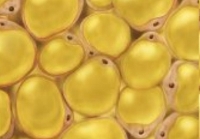Laser lipolysis
 Adipose tissue is a type of connective tissue, located mainly beneath the skin. It is composed mostly of fat cells (adipocytes).
Adipose tissue is a type of connective tissue, located mainly beneath the skin. It is composed mostly of fat cells (adipocytes).
Postnatally, an organism has about 30 million fat cells, whose main role is storing energy in the form of triglycerides. Adipose tissue makes up 20-25% of body weight in women and 15-20% of body weight in men.
There exist two types of adipose tissue:
1) white adipose tissue (yellow): characterised by small mass of intercellular substance. The cells of yellow adipose tissue contain a large lipid droplet surrounded by a thin layer of cytoplasm. The main function of this tissue is storing fat, and also fat production (lipogenesis) and breakdown (lipolysis).
2) brown adipose tissue - characteristic in mammals. It is present in almost all newborns, develops in the last two months of gestation period, a fully developed form is present in neonates (newborn infants) and then it gradually disappears. It is located between shoulder blades, around neck, mediastinum, large arteries and kidneys. Its primary function is to generate body heat.
Obesity - is a pathological condition in which excess body fat has accumulated to the extent that it exceeds the body's physiological needs and adaptability, which may lead to adverse effects on health. People are considered obese, when their adipose tissue makes up more than 20% of their total body mass in men and 25% in women. Obesity is accompanied by overweight, meaning greater body weight from what is considered the optimum body mass.
Lipolysis - is a process involving hydrolytic breakdown of triglyceride in the adipose tissue into free fatty acids and glycerol, which are released into the bloodstream and taken up by most tissues (except for the brain and erythrocytes) and esterified to acylglycerols or oxidized as the main source of energy to carbon dioxide and water.
Types of laser lipolysis treatments:
1) ultrasound/cavitation lipolysis,
2) injection lipolysis,
3) cryolipolysis,
4) laser (invasive and non-invasive transdermal systems);
Comparison of fat reduction methods:
Technology |
Low energy diode laser 650-660 nm |
High energy diode laser 940 nm |
How it works |
Removal of fat from fat cells |
Destruction of fat cells |
The effect on skin quality after treatment |
Cellulite reduction with head Ultra |
Retraction of collagen fibres, effect of skin modelling |
Influence on blood vessels |
None |
Minimal damage, laser coagulates vessels during the session |
Anaesthesia |
None |
Tumescent anaesthesia |
Additional tests |
None |
Complete Blood Count (CBC), liver tests, blood coagulation system |
Duration of a single session |
20-40 minutes |
1-3 hours |
Number of required sessions |
A series of 8 sessions |
1 session |
Recommendations after treatment |
Diet, training |
Compression clothing, lymphatic drainage |
Conditions for the effect durability |
Regular caloric balance |
The damaged cells do not regenerate, the excess calories are deposited in other body areas |
Cost |
about 500zł/1 session/1 body area |
1800-3500zł/1 body area |
The mechanism of action of the two methods can be best illustrated in the following way:
i-lipo: removal of fat from fat cells can be compared to the effect of dried grapes - delivering the excess energy may turn the raisins into juicy grapes again. For maintenance of the effects, a balanced diet and physical activity are required.

Laser Lipolysis Velas: the treatment damages the fat cells permanently (they die like soap bubbles). Caloric surplus is stored as fat in other places - finally, there is a chance, that the eaten donut instead of enlarging our belly and hips, will enlarge our...breasts...


